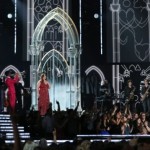Every Monday in Citizenship Confusion, Alan Noble discusses how we confuse our heavenly citizenship with citizenship to the state, culture, and the world.
This video was released on the Elevation Worship site with the following statement:
“This past weekend we opened our worship experience of ‘All Creatures Of Our God And King.’ Incredible hymn. Obviously. We wanted to lead it through a vocoder and some auto-tune to get creative at each of our campuses as we kicked off our new series ‘The Prodigy In Me.’ And now we want to share it with you guys. Hope you enjoy.”
I believe we have tremendous freedom in our worship. We are not restricted to a cappella, the Psalms, traditional hymns, traditional hymns reworked, or contemporary praise and worship. However, I do believe that our purpose in worshiping is strictly defined and that certain forms of worship pursue that purpose better than others.
Aside from giving glory to God, Paul tells us in Colossians 3:16 that we are to encourage each other with psalms, hymns and spiritual songs. In other words, there is both a vertical and horizontal vision to worship. We sing to God to glorify Him and with our brothers and sisters to encourage them. What we don’t do is sing to glorify ourselves or to feel or experience something. Worship goes outward, away from us, which is one reason that we sing. Our words literally leave us and journey to God and our neighbor for His honor.
Our culture’s music has a quite different purpose: to please, to entertain, and to delight, amongst other things. What is key is that at a secular concert our attention is (usually) drawn toward the performer and/or internally to our emotions and experience. And this is appropriate for other forms of music, music that is not intended as worship. But when worship music gets confused with secular music, as I believe happens with Elevation’s cover of “All Creatures…” the focus gets directed to the worship band and/or leader and towards the internal experience of hearing the song.
The lighting, camera work, staging (leader at center-stage), and even appearance of the leader (attractive male with hip clothing and perfectly mussed hair) all work to draw our attention toward the worship leader as the focus of the song.Worst of all, the orchestration of the song inherently excludes the voices of the congregation almost entirely. The common practice of raising the volume of the worship leader’s vocals far, far above those of the congregation is often a distraction from the communal focus of worship, but to use a vocoder and auto-tune significantly exacerbates the problem. The leader’s voice is completely foreign to the congregation’s voices (except, I suppose, the voices of any robots). Rather than emphasize unity and equality before Christ, the song emphasizes the dramatic difference between the band and the church. The congregation is left on the outside of the worship experience, literally in the dark of the audience.
Audience. Here we come to the crux of the problem. The congregation, a community meeting in the Lord’s house to share in the Lord’s table, to hear the Lord’s Words, and to sing glory to the Lord is confused with an audience.
While we have great freedom to be creative in our worship, we should use our creativity for the purpose of glorifying God and encouraging one another, not simply “to get creative.”











